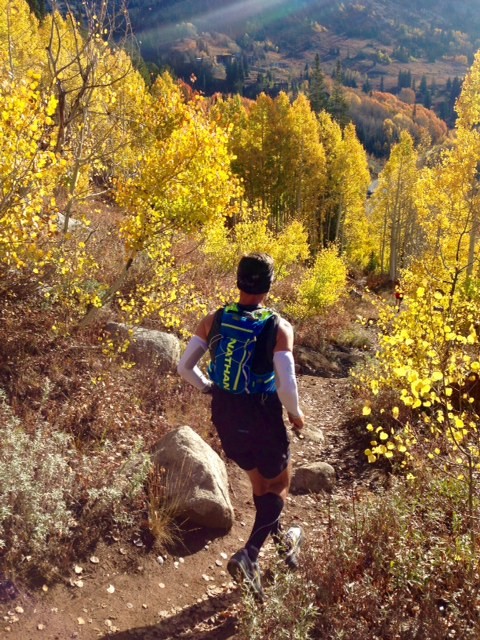By Taralyn Summers
Are you Ready to Make the Change?
I can still see the look on their faces when I showed up to run. I was there to run one of the biggest peaks I’d run since transitioning from the road to the trails in 2014. With my minimalist road shoes tightly fastened and a headlamp securely mounted, I was ready to climb the next seven miles to Mount Timpanogos, a popular 11,700+ Utah peak. As I approached the group, I could sense their curiosity and concern regarding what I was wearing and what little I had brought with me. I wasn’t worried, though. In my hand, I had a 16-ounce handheld—it was July—and a single gel to make it through my last hour. Besides, it was only a 14-mile round trip run, and I had previously completed several marathons. To me, everyone else looked like a bunch of over-packers. How long were they planning to stay up there anyway? So, the trek up the mountain began, and for the next 4.5 hours, it became very apparent that I had joined a group of experienced trail runners. My previous familiarity with marathons had little carry over into this new world of trail running. Over the next few months, these friends patiently demonstrated how to successfully transition from the road to the trail.
Lose minutes to save hours
Runners don’t walk, they run! Even on the uphills, runners are running. Walking is almost seen as a form of weakness for the hardcore runner. It’s a road running mentality to keep your pace and to keep up your cadence. However, on the trails, the mentality is vastly different. Depending on the distance and ascent, the amount of hiking will vary according to your fitness and level of experience. The 8:00 min/mile pace could turn into a sweet 15:00 min/mile, and that’s sucking air in the process. It’s not uncommon to see novice trail runners attempt to burn it up every hill, to find they have only gained a few seconds over the others and have spent their energy with little return. It’s not about the pace, it’s about conserving energy economy while covering the distance. Forget about the pace and focus on the effort.
Gear up
Having the right kind of gear is essential when it comes to being prepared to cover any terrain. Have you ever heard that running is the easiest and cheapest sport to pick up because all you need is a pair of running shoes? Although somewhat debatable, this is even less true when it comes to trail running. Be prepared to invest in a few items to transition more smoothly.
Hydration vests are largely used by trail runners to carry water, fuel, extra layers, a phone, and other necessities to comfortably cover the terrain. Carrying wipes and other sanitary items are also suggested in case Mother Nature calls, as it often does. And yes, you use the bathroom outside, kind of like a dog.
In colder conditions, be prepared to bring items such as spikes (for ice and snow), gloves, and gaiters for added protection in a harsher environment.
It’s also important to find a good headlamp for those dark runs. While having a headlamp is nothing new to runners, having a bright headlamp on the trails is especially important for optimal vision to avoid tripping over roots, rocks, and other unseen barriers that are generally not a concern on the road.
Invest in a good trail shoe and leave your road shoes behind. The difference will be night and day when you make the switch. If you plan to do more climbing or scrambling, plan to wear a shoe with a more aggressive tread and a “grippy” feel. For trail runs with less climbing and smoother groomed trails, a less aggressive trail shoe would suffice in place of a “cleat” type of tread. Most importantly, choose a shoe that can handle the terrain so you can avoid serious falls or painful trips. Just like any road shoe, find the right pair(s) for you by doing your own research or go to your local running store for help. At the end of the day, find what works for you and go with it.
Safety in numbers
It’s no surprise that people are drawn to the trails for its unsurpassed scenery. However, running in Mother Nature’s rural settings can pose more threats than what you might encounter running through your neighborhood subdivision. Therefore, consider running with a partner or in a group. There are a number of issues that can arise on the trials, leaving it difficult to get help if needed. Seek out other trail enthusiasts in your area or join an existing trail group on social media. If you can’t find existing groups, make your interests known. You might be surprised how many people out there have always wanted to run on the trails and might take up the sport with you. And let’s be honest, company makes it more fun!
Training
Lastly, consider the amount of time you have to train. From an overall slower pace, to commuting for most, training on the trails can take a more significant amount of time. This means even earlier mornings, longer lunch breaks, and perhaps even longer babysitter times. As long as you plan accordingly, you can find the time and balance it with all areas of your life.
Whether it’s on the road or trail, make sure you’re prepared for the run ahead. And if you’re not sure which route to take, why not try getting your shoes a little dirty and discover what Mother Nature has to offer.





















[…] Five steps from the road to the trails. […]
Nice quick intro for the uninitiated.
This made me laugh when you said you were going to do a 14 mile round trip up a serious mountain, not at you, but with you as I remember the feeling when I crossed over.
Thanks for helping to teach others. I still know road runners who wonder why it takes so long for my long runs (usually all trails and a couple 1000 feet of elevation gain or more). It is a very different world, not necessarily better, well I think it is, just different challenges.
Have an amazing day and happy trail running,
Adam.